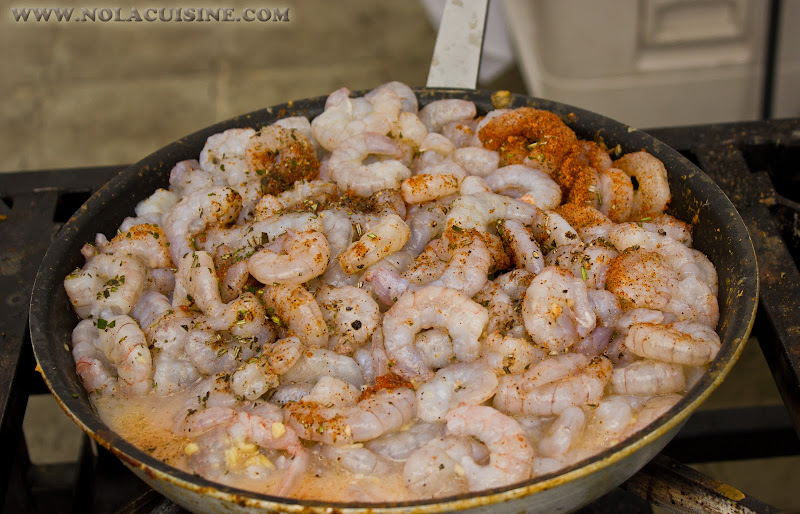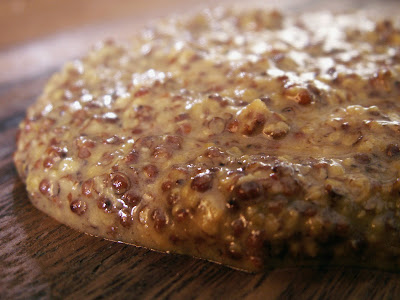 |
| From New Oyster Festival 2011 |
I meet many wonderful people through this blog, most of which I never get to meet in person. I met Seth McMillan, this way and later through Facebook, so when I knew I was coming down to New Orleans for a visit I sent him a message saying we should try to get together, he suggested we go check out the Second Annual New Orleans Oyster Festival that was happening on the same dates of my trip, great call!
We met up at about 8:30 a.m. on the Sunday morning, both a little rough around the edges from the night before. I followed Seth’s lead by grabbing a Gatorade from the Walgreens across from Jax Brewery where the festival was being held. Another great call…electrolytes. I like this guy already!
Seth is a Sous Chef at Bourbon House Seafood Restaurant and an all around great guy. He does the seafood ordering for the restaurant, so he shared a lot of interesting information about ordering Seafood in New Orleans, and about all of the vendors and purveyors that he deals with in the day to day. We shared restaurant stories, talked food and eventually ended up at the Bourbon House bar for eye openers until the festival opened up (by the way, the frozen Bourbon Milk Punch at Bourbon House is a hell of a way to start the morning, loved it!)
After some good conversation at the bar with the bartender, who colorfully relayed a story of his early morning run in with a very hungover guest of the hotel, which had my sides splitting, we headed over to the festival with a nice lady that was at the bar when we arrived, who needed someone to walk over with. After making sure the bartender got our descriptions she said:
“I should be crazy walking away with two strange guys in the city, but at least there are like a million people around!”
To which I jokingly replied:
“That’s what alleys are for.”
But alas, we arrived safe and sound after a few hundred abduction jokes and said goodbye to the nice lady whose husband was working at the festival. We then did a flyby of all of the tents to see what they were offering.
 |
| From July 21, 2011 |
Here is a listing of the restaurants that were there and what they were serving.
After the flyby we stopped at the Drago’s tent. It was a windy day, with a little bit of welcomed rain that kept the temperature, still hot, but almost livable. The wind carried huge gusts of aroma from Drago’s famous Charbroiled Oysters deep into the Quarter. Later in the day we were on Chartres and were caught in a smell storm of charcoal, oysters and cheese sauce flare up, that made my mouth water. Here are some of the grill men working the Oysters.
 |
| From July 23, 2011 |
Drago’s Restaurant owner Tommy Cvitanovich was on hand and let me get a few pictures of Drago’s Char-Broiling Fire Engine, complete with flat screen TV’s, tappers of Abita Amber, and a Jagermeister dispenser.
 |
| From July 21, 2011 |
Tommy dispensing the Jager!
 |
| From July 21, 2011 |
Drago’s Char-Broiled Oysters are in my humble opinion, one of the best damned ways to eat a Louisiana Oyster! I even created my own recipe to try to duplicate them at home. In fact, I proudly announce that my photo from the same shoot from that post is being used on the cover of The Louisiana Seafood Bible: Oysters!
 |
| From Louisiana Seafood Bible – Oysters |
Here is the recipe:
Drago’s Style Char-Broiled Oysters Recipe
| From November 21, 2011 |
Here is the real deal from the festival!
 |
| From July 21, 2011 |
After visiting the Drago’s tent we decided it was time for an ice cold Abita Amber:
 |
| From July 21, 2011 |
While hanging around the beer tent Seth ran into, and introduced me to Sal Sunseri of P&J Oyster Company, which is absolutely legendary in New Orleans, and unfortunately, is still reeling from the effects of the BP Oil spill damage to the Louisiana Oyster beds. In fact, the Oyster Festival was started last year to educate the country about the benefits and importance of the Louisiana Gulf Oyster, as well as to showcase the restaurants and the dishes that they create from them. P&J also has a wonderful cookbook:
Sal Sunseri and Seth McMillan:
 |
| From July 21, 2011 |
While hanging near the Abita Beer tent we stopped and checked out James Andrews Band, I absolutely love this photo that I caught of the incredible trumpeter James Andrews at work!
 |
| From July 21, 2011 |
I also have to say, as incredible of a food experience that I always have in New Orleans, I also always have an equally incredible music experience! Hopping clubs on Frenchman Street at all hours, the Monday night Super Jam at Maison! Street Musicians galore! Rebirth Brass Band at Maple Leaf Bar on Tuesdays. More on the music in a later post, on to more food!
Fried Oyster Po Boy with Smoked Tomato Relish from John Besh’s restaurant Luke:
 |
| From July 21, 2011 |
i
These are Oysters from the largest Oyster Contest, they are easily bigger than my opened hand.
 |
| From July 21, 2011 |
Oyster Rockefeller Bouhe from Royal House, Seth said that this was his “guilty pleasure” of the day!
 |
| From July 21, 2011 |
The last stop was Bourbon House‘s tent, because Seth works there I got a behind the scenes view of the cooks making what was one of my favorite things to eat at the festival, Barbecue Shrimp, for the Barbecue Shrimp Po Boy. The second photo being one of my favorites from my whole trip! I love food photography, maybe because it’s hard to go wrong! If the food looks appetizing it is an amazing photo opp!
 |
| From July 21, 2011 |
 |
| From July 21, 2011 |
The finished product Barbecue Shrimp Po Boy from Bourbon House!
 |
| From July 21, 2011 |
The other offering from Bourbon House, Seth’s choice, and a good choice, Mcilhenny Oysters! He gave me a sample of an Oyster before he dug in, absolutely delicious, perfectly fried and the sauce was a perfect compliment! This is also one of my favorite pics from my visit!
 |
| From July 21, 2011 |
These festivals are such an incredible way for visitors and locals alike to sample the wares of a lot of different great restaurants in one spot, not to mention listen to some great live music!
After we were done with the Festival, Seth and I continued to hang out and decided to jump in my rental car and go find an awesome restaurant to check out, the city was our Oyster, pun intended, but as we found out, Sunday afternoon is no time to dine in New Orleans.
Boucherie…closed, Dante’s…closed, this little place right there I heard about has great…DAMN…closed! Look at this a Tapas bar off of St. Charles, the door’s open! Finally! Let’s go check it out! How ya doin?
“Good, but we don’t open until 5 o’clock. Sorry.”
DAMN IT!!!! Ahh, excuse me…Do you have a bathroom? Great, thanks.
The afternoon was a relentless barrage of closed signs and shuttered doors, we had nothing to do but laugh by the end of it. It was either laugh or cry.
We ended up at the mostly unlikely place for two educated diners to be eating in New Orleans. Jackson Square??? How the hell did we end up back here? Next stop:
Be sure and check out my ever growing Index of Creole & Cajun Recipes which provides links to all of the recipes featured at Nola Cuisine!



